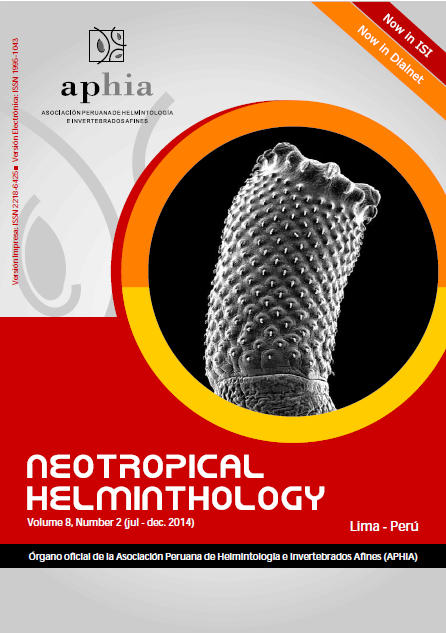MONOGENOIDEA AND DIGENEA PARASITES OF THUNNUS ATLANTICUS (PERCIFORMES, SCOMBRIDAE) FROM RIO DE JANEIRO COAST, BRAZIL
DOI:
https://doi.org/10.24039/rnh201482926Keywords:
Digenea, Fish parasites, Monogenoidea, Scombridae.Abstract
Thunnus atlanticus is of great commercial importance in Brazil, but infections caused by helminth parasites can reduce its commercial value. In this paper, 15 species of Digenea and three of Monogenoidea were recovered from 61 specimens of T. atlanticus collected from the coastal zone of the State of Rio de Janeiro. Species of the family Didymozoidae were the dominant species, with highest prevalence and abundance values. The parasites showed the typical aggregated distribution pattern, except for Nasicola brasiliensis, which had an aleatory distribution pattern. Prevalence and abundance of Didymosulcus philobranchiarca, Didymocystis lamotheargumedoi and Didymosulcus wedli and prevalence of Koellikerioides internogastricus were positively correlated with the total length of the host. The abundance of Coeliotrema thynni was negatively correlated with total length of the host. New hosts records resulted for four Digenea: Didymosulcus orbitalis, Didymosulcus wedli, Rhipidocotyle pentagonum and Lecithochirium microstomum, and one Monogenoidea: Nasicola brasiliensis.
Downloads
Published
How to Cite
Issue
Section
License
Copyright (c) 2021 Neotropical Helminthology

This work is licensed under a Creative Commons Attribution-NonCommercial-NoDerivatives 4.0 International License.
OBJETO: El AUTOR-CEDENTE transfiere de manera TOTAL Y SIN LIMITACIÓN alguna al CESIONARIO los derechos patrimoniales que le corresponden sobre la (s) obra(s) tituladas: xxxxxxxxxxxxxxxx, por el tiempo que establezca la ley internacional. En virtud de lo anterior, se entiende que el CESIONARIO adquiere el derecho de reproducción en todas sus modalidades, incluso para inclusión audiovisual; el derecho de transformación o adaptación, comunicación pública, traducción, distribución y, en general, cualquier tipo de explotación que de las obras se pueda realizar por cualquier medio conocido o por conocer en el territorio nacional o internacional.
REMUNERACIÓN: La cesión de los derechos patrimoniales de autor que mediante este contrato se hace será a título gratuito.
CONDICIONES Y LEGITIMIDAD DE LOS DERECHOS: El AUTOR-CEDENTE garantiza que es propietario integral de los derechos de explotación de la(s) obra(s) y en consecuencia garantiza que puede contratar y transferir los derechos aquí cedidos sin ningún tipo de limitación por no tener ningún tipo de gravamen, limitación o disposición. En todo caso, responderá por cualquier reclamo que en materia de derecho de autor se pueda presentar, exonerando de cualquier responsabilidad al CESIONARIO.
LICENCIA DE ACCESO ABIERTO: El AUTOR-CEDENTE autoriza que manuscrito publicado en La Revista Neotropical Helminthology permanece disponible para su consulta pública en el sitio web https://www.neotropicalhelminthology.com/ y en los diferentes sistemas de indexación y bases de datos en las que la revista tiene visibilidad, bajo la licencia Creative Commons, en la modalidad Reconocimiento-No comercial- Sin Trabajos derivados –aprobada en Perú, y por lo tanto son de acceso abierto. De ahí que los autores dan, sin derecho a retribución económica, a la Asociación Peruana de Helmintología e Invertebrados Afines (APHIA), los derechos de autor para la edición y reproducción a través de diferentes medios de difusión.


 Numero 2 Volumen 19 - 2025 (versión Anticipada)
Numero 2 Volumen 19 - 2025 (versión Anticipada)














































